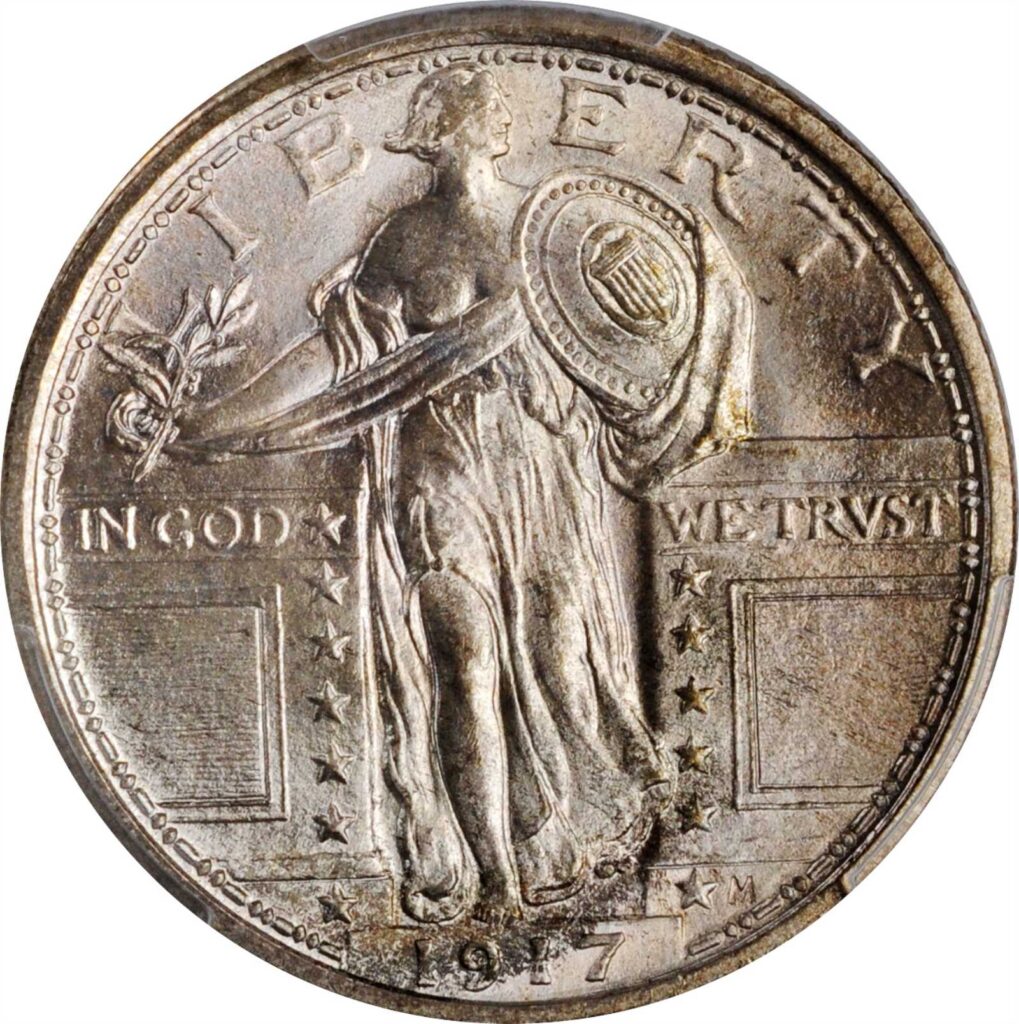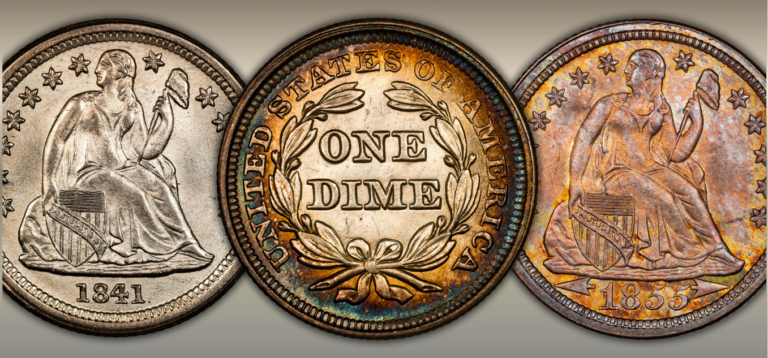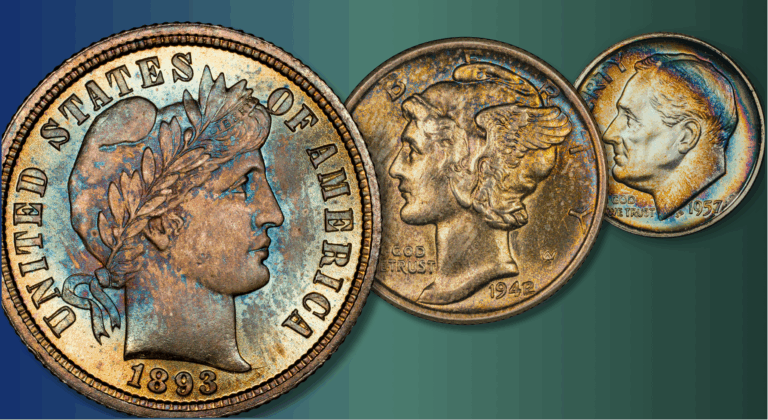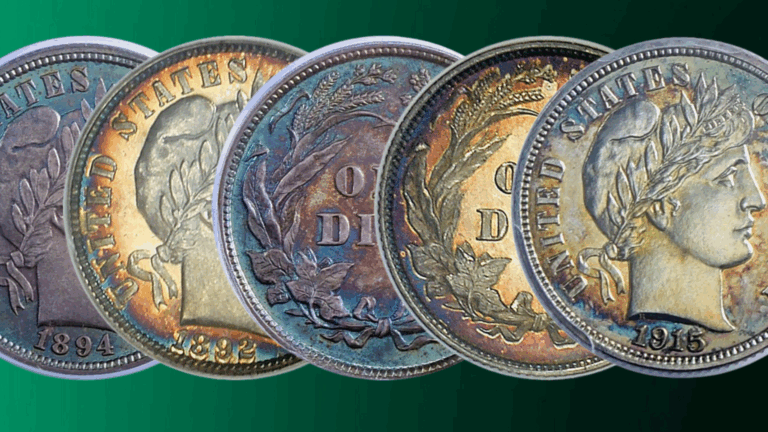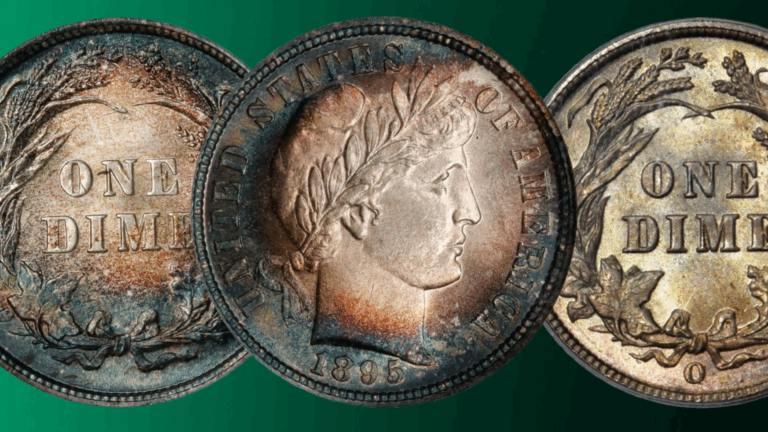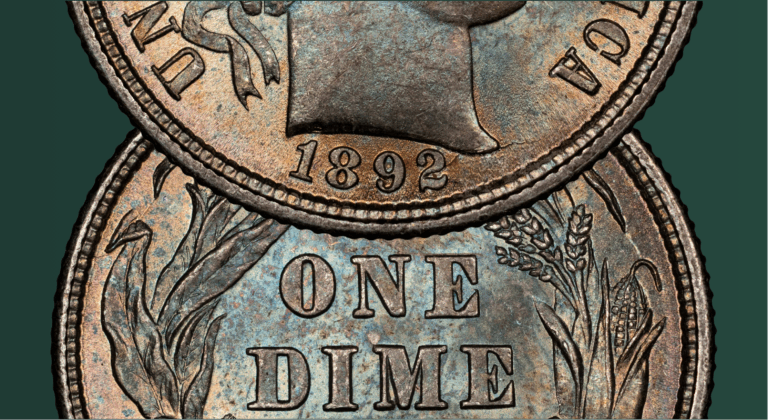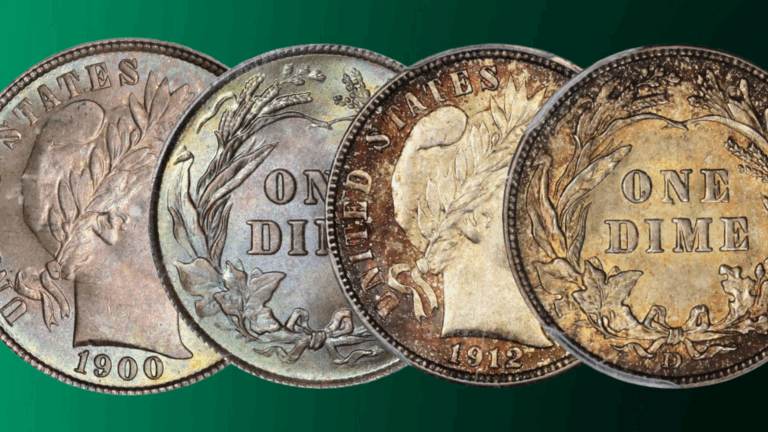by Greg Reynolds
Excluding one or two key dates, without spending a fortune, it is practical to complete a set of Choice (MS-63 grade) to Gem (MS-65 or higher) Uncirculated Standing Liberty quarters (SLQs), which were minted from 1916 to 1930. Although some dates are very scarce in MS-63 and higher grades, all are obtainable with patience and a significant budget. Less affluent collectors can easily build a set in sub-58 grades, a topic for another discussion. Here, the focus is on appealing Very Choice (MS-64) to Gem Uncirculated (MS-65 grade) coins that are realistically obtainable.
It is best to refer to each Standing Liberty Quarter as an SLQ and all Standing Liberty quarters as SLQs. It is time consuming to say or write the same name, ‘Standing Liberty quarter,’ over and over again. SLQs could have been fairly called ‘MacNeil Quarters.’ The Barber Quarter (1892-1916) has been named after its designer, Charles Barber.
A rather famous sculptor, Hermon MacNeil, won a contest to design the new quarter in 1916. A law that was effected on Sept. 26, 1890 allowed the Director of the U.S. Mint, with approval of the Secretary of the Treasury, to change coin design types without congressional involvement, provided that each design type being replaced was adopted twenty-five or more years earlier. As Barber Quarters were first minted in 1892, twenty-five years had elapsed.
Hermon MacNeil’s career and the symbolic meanings of the design elements of SLQs really merit their own discussions, though are referenced in an online article that I wrote in 2014. There is not a need, however, to know the history of art, philosophy or American foreign policy to collect SLQs. Personally, I figure that learning about such topics in the context of classic U.S. coins enhances the process of coin collecting, and makes collecting more enjoyable. Others, however, think differently and just focus on the coins. For most buyers, coin collecting is more about the coins themselves than about history. Besides, it is not practical to cover all interesting aspects of SLQs in one discussion.
Standing Liberty Quarters, Types and Mints
SLQs were struck at mints in Philadelphia, Denver and San Francisco. Until the 1940s, no Philadelphia Mint coins had or were supposed to have mintmarks. Coins minted in ‘Denver’ feature a letter ‘D.’ An ‘S’ mintmark stands for the San Francisco Mint.
The mintmark, if there at all, is on the reverse (back) of most classic U.S. coin issues. Regarding SLQs, Lincoln cents, “Reeded Edge” (really Gobrecht) half dollars (1836-39), early Walking Liberty half dollars (1916-17), and a few other classic U.S. coin types, the mintmark is on the obverse (front of the coin). On SLQs, a ‘D’ or an ‘S’ mintmark is just above and to the left of the numerals of the year, which is often called ‘the date.’
In 1916, SLQs were not minted until December and were struck only in Philadelphia. These are scarce, though obtainable. Curiously, two design types or variations of SLQs were minted in 1917. On 1916-17 (Type One) SLQs, one of Miss Liberty’s breasts is exposed and the flying eagle is low on the reverse (back of the coin).
On 1917-30 (Type Two) SLQs, armor covers her breasts and much of her upper body. The eagle is higher on the reverse, closer to the center. Three of the thirteen stars on the reverse were moved and placed below the eagle in the design of the Type Two SLQ.
I theorize that the armor relates to military advances of the United States embodied by the Spanish-American War of 1898, past President Theodore Roosevelt’s foreign policy, and the decision by President Woodrow Wilson, along with Congress, in April 1917 to enter the first World War. There is no evidence of a public outcry regarding Miss Liberty’s exposed breast and there were other ways of covering her chest. Armor has a military significance. The law authorizing the change in the design of SLQs was not passed until July 1917, just around three months after the U.S. Congress declared war on the Imperial German regime of Kaiser Wilhelm II.
Beginning in 1925, SLQs were struck with a slightly modified obverse design to slow down the wearing in circulation of the numerals of the year (‘the date’). These numerals were not adequately protected in the original design, and some people complained about receiving dateless SLQs in change. On SLQs minted from 1925 to 1930, the numerals wore down much less rapidly.

Are Full Heads Worth Large Premiums?
The strangest aspect of the minting of SLQs was that many were struck with poorly defined or even blank ‘caved in’ heads of Miss Liberty. Only a minority of SLQs were struck with sharply defined heads of Miss Liberty. All grading services designate some SLQs as having a ‘full head’ (FH).
A FH designation has monetary value as, all other things being equal, an SLQ with a FH designation is worth more, much more in some cases, than a corresponding SLQ that is not so designated. Unfortunately, the matter is not simple. There has not been a clear division at all grading services between a ‘FH’ and an SLQ that does not merit a FH designation. Also, a coin that has two-thirds of a ‘Full Head’ becomes grouped with a coin that has only one-fourth of a head as both will fail to receive a FH designation.
During the 1990s, it was common for grading-wholesalers to remove SLQs from their holders and resubmit them to grading services with the idea of receiving a FH designation. Furthermore, coin doctors added sculpted sticky metal alloys or other substances to flat heads to make them appear ‘full’ to expert graders. The fact that heads are far more likely to be full on some dates makes the issue even more mysterious. The most puzzling aspect, however, is that an SLQ may have a ‘FH’ and obviously lack detail elsewhere on the coin. A ‘FH’ SLQ is not necessarily fully struck.
In regards to assembling a set in which most SLQs do not have FH designations, the 1916 and the 1918/7-S are dramatically more expensive than the other coins in the set. As I strongly recommend against building a FH-only set, I am not commenting here upon the most expensive with ‘FH’ designations, though the costs of Choice to Gem quality 1919-D, 1919-S and 1920-S SLQs, with FH designations, can be exorbitant. It really makes more sense to buy SLQs of these dates without FH designations.
As a collector assembles most of the set and develops thoughts about SLQs, he or she will probably think about the 1916, the 1918/7-S and whether any FH certification rarities are worth pursuing. Each collector is different. I aim to provide information and advice that collectors may use in the process of making their own decisions. There is no collecting rule or method that is applicable to all collectors of SLQs. A majority of collectors who focus upon SLQs, though, seek to assemble sets, including six SLQs from the year 1917.
The First Type
Both Type One and Type Two 1917 quarters were struck at all three mints. The heads tend to be better defined on Type One SLQs than they are on Type Two SLQs.
As of June 18, 2024, CAC has approved only eleven Type One 1917 SLQs in the MS-64 range, without an FH designation, and 176 with a ‘Full Head’ (FH) designation, including three in CACG holders. The CPG-CAC retail price estimate for an MS-64-FH 1917 Type One is significantly higher than the retail estimate for an MS-64 grade coin without a FH designation, $960 vs. $585. For Type One SLQs, however, MS-64 or MS-65 grade coins with a FH designation are much easier to find than those without.
On April 16, 2023, the firm called GreatCollections sold a CAC approved, NGC graded MS-63 1917 Type One SLQ for $506. Although the $506 price realized is a little steep for a MS-63 grade coin of this date, this coin features substantial head, breast and shield detail, in addition to neat toning and luster.


The CPG-CAC retail estimate for a Type One 1917-D is $1350 for a CAC approved MS-64 grade coin with a FH designation and $650 without a FH designation. Just seven 1917-D Type One SLQs in MS-64 without a FH designation were approved by CAC, and fifty-nine with a FH designation. On March 10, 2024, GreatCollections sold a CAC approved, PCGS certified MS-63-FH 1917-D for $698.50, much less than a CAC approved MS-64-FH 1917 Type One SLQ would be likely to cost.

Almost all of the uncirculated Type One 1917-S SLQs certified by CAC have a FH designation. CPG-CAC retail estimates are: MS-63-FH $1460, MS-64-FH $1980 and MS-65=FH $3000. It is not hard to find one of these, though patience may be required.
The Second Type: 1917-30
For many dates in the series of Type Two SLQs, a CAC approved MS-64 grade SLQ without a FH designation, but with considerable head detail, may be purchased for a price in the range of $400 to $600. For example, on April 28, 2024, GreatCollections sold a PCGS graded MS-64 1924-D, with a sticker of approval from CAC, for $418.02. On Dec. 10, 2023, GreatCollections sold a PCGS graded MS-65+ 1924-D, without a CAC sticker, for $610.50.
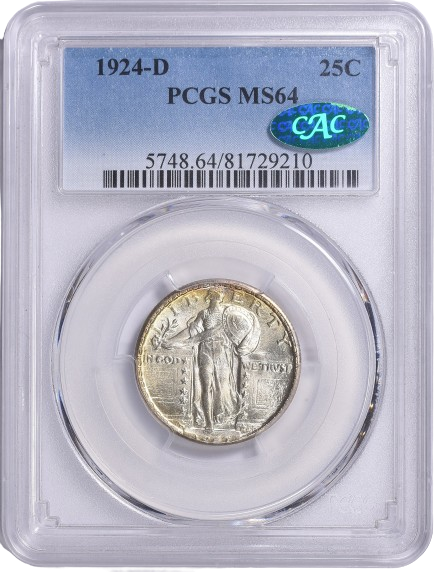
To compute the price realized in a GreatCollections sale, it is accurate to add 10% to the ‘hammer price,’ the winning bid. In the history of coin auctions, it is customary to regard credit card surcharges, PayPal percentages, sales taxes, and shipping expenses, as additional fees, not components of prices realized.
Though certainly not among the relatively common dates like the just mentioned 1924-D, Type Two 1917, 1917-D and 1917-S SLQs are not difficult to find. On March 31, 2024, GreatCollections sold a CAC approved MS-64-FH 1917 Type Two SLQ for $1072.50. This coin is in a rattling PCGS holder from the 1980s.


The 1918-D and the 1918-S are certainly ‘better dates’ and are CAC rarities in MS-63 to -65 grades. Pertinent CPG-CAC retail estimates for the 1918-D are: MS-63-FH $1080, MS-64 $740, MS-64-FH $1720, and MS-65 $1800. Although it may seem like a good deal to buy a CAC approved MS-64 1818-D for $740, the existence of a price guide value does not demonstrate that a collector will be able to find a corresponding coin for that guide price, or find a high grade 1918-D in the near future. It might be a good idea to budget $1000 to $2000 for a 1918-D that grades in the MS-64 to -65 range.
For the 1918-S, the CAC population in MS-63 is two with a FH designation and three without, a total of merely five. In MS-64, the CAC pop is eleven 1918-S quarters with a FH designation and twelve without, three and thirteen in MS-65. A collector probably would not have to wait a long time for an opportunity to acquire a 1918-S in the MS-64 to -65 range.
A CAC approved MS-64 grade 1919 could be found for less than $500. Assuming I like the specific coins being considered, I would rather pay the CPG estimate of $780 for a CAC MS-66 grade 1919 without a FH than the CPG value of $1500 for a MS-65-FH 1919. Again, many SLQs without a FH designation feature two-thirds or more of a head, 80% of a head in some cases. I do not feel a need to see Miss Liberty’s ear anyway.
The 1919-D and the 1919-S are leading semi-keys. There would probably be a need to spend thousands for a CAC approved MS-63 to -65 grade 1919-D and maybe even more for a 1919-S.
It should be relatively easy to find a well detailed 1920 SLQ without a FH designation, perhaps a MS-64 grade coin for less than $425. The 1920-D is clearly a condition rarity in the MS-63 to -65 range and is not fully recognized as such.
I suggest that collectors quietly pursue selected 1920-D SLQs as they become available. A calm collector will be able to secure a pleasant 1920-D for a fair price, eventually. A collector who leaps high into a bidding war in a major auction, after contracting auction fever, may find himself paying a great deal for a 1920-D.
Regarding the 1920-S, those with FH designations are extreme certification rarities. It definitely makes sense to plan to acquire a 1920-S without a FH designation. CAC has approved six as MS-63, thirteen as MS-64 and seven as MS-65, as of June 18, 2024.

Show off Your Collection in the CAC Registry!
Have CAC coins of your own? If so, check out the CAC Registry–the free online platform to track your coin inventory, showcase your coins by building public sets, and compete with like-minded collectors!
Type Two during the Recession of the 1920s
Due to the severe recession of 1920-21, SLQs were minted only in Philadelphia in 1921 and nowhere in 1922. I recommend avoiding 1921 SLQs with FH designations; the MS-63-FH and MS-64-FH 1921 SLQs are CAC certification rarities and MS-65-FH 1921 SLQs cost much more than their non-FH counterparts.
On March 31, 2024, GreatCollections sold a CAC approved, PCGS graded MS-64 1921 for $2740.10. If it had a FH designation, this 1921 probably would have realized at least 45% more.
A CAC approved MS-64 or -65 1923, without a FH designation, is easy to buy for less than $600, maybe even for less than $425! On Jan. 14, 2024, GreatCollections sold a CAC approved MS-63 grade 1923 for $298.09.
The 1923-S is a semi-key. A collector building a set should be prepared to pay thousands for a MS-64 to -65 grade 1923-S.
The 1924 is one of the least scarce dates. Back in 2020, GreatCollections sold a CAC approved MS-64 grade 1924 for $357.50. The current CPG-CAC retail price estimate is $470, though there is a good chance that a collector could buy a CAC approved MS-64 grade 1924 for less than $450 in an auction or at a coin show in 2024 or 2025.
Budget-minded collectors may be tempted to place coins that are certified in the MS-60 to -63 range in a set of predominantly MS-64 grade SLQs, yet I usually recommend against such substitutions. For almost every date, curiously, CAC approved SLQs in the MS-60 to -63 range are rare, often much rarer than CAC approved MS-64 to -65 grade SLQs of the same respective dates. Moreover, many SLQs in the MS-60 to -63 range are not excellent coins. Most of them are characterized by many noticeable hairlines, ‘washed out’ surfaces, or other technical negatives that are very annoying.
In the MS-63 to -65 grade range, the 1924-D is a fairly common date. The 1924-S is definitely a better date, though it is not prohibitively rare in grades above MS-63. As of June 18, 2024, CAC pops for the 1924-S, without a FH designation, are four in MS-63, thirteen in MS-64, ten in MS-65 and ten also in MS-66.
The CPG guide gives the impression that the 1925 is a relatively common date, though I have not seen many MS-64 to MS-66 grade 1925 SLQs over the past two decades. The CAC pops for the 1925 and the 1926 are in the same category. Without a FH designation, the MS-64 and MS-66 CAC pops for the 1926 are notably higher than those for the 1925, and are about the same for MS-65 grade coins. CAC has stickered twenty-two PCGS or NGC graded MS-65 1926 SLQs without a FH designation and twenty-three 1925 SLQs.
A decent 1926 in MS-64 or -65 grade, without a FH designation, though with much of a head, should not be difficult to find for a relatively low price in the context of market levels for SLQs. On Dec. 10, 2023, GreatCollections sold a CAC approved MS-64 grade 1926 for $368.50. Though not entirely full, the head on this SLQ is fairly well struck.
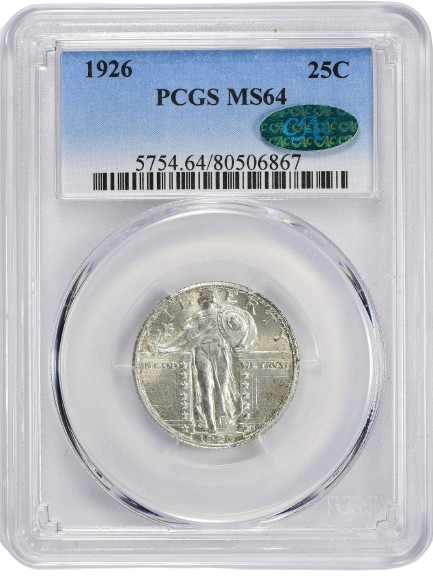
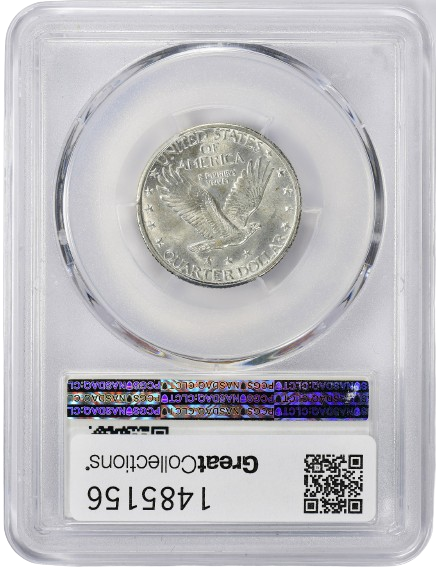
In most cases, I recommend against buying a 1926-D with a FH designation. These are among the least scarce SLQs without FH designations and are extreme rarities with FH designations, really! For a MS-64 grade 1926-D, the CPG-CAC retail guide value is $475 without a FH designation and the CPG-CAC value is $15,000, more than thirty-five times as much, for one with a FH designation. Nonetheless, there is no need to settle for a 1926-D with a head that appears like it has been bludgeoned. There are many surviving 1926-D SLQs with two-thirds or more head detail.
On May 26, 2024, GreatCollections sold a CAC approved MS-65 grade 1926-D for $510.88. Though not close to having a ‘Full Head,’ the head detail on this coin is sufficient, in my view. Miss Liberty’s nose, eye socket and much of her hair are discernible.
The 1926-S is a semi-key. Although price guides indicate that MS-60 to -63 grade 1926-S SLQs are not extremely expensive, it might be extremely difficult to find a CAC approved MS-60 to -63 grade 1926-S. CAC has approved zero as MS-60, zeros as MS-61, one as MS-62, which is in a CACG holder, and three as MS-63. CAC has, however, approved sixteen as MS-64, with just one of the sixteen having a FH designation, and twelve as MS-65, three of which have FH designations.
Late Dates: 1927-30
The 1927 is traditionally held to be a very common date. Nevertheless, CAC approved 1927 SLQs in grades in the MS-64 to -66 range are not plentiful. While the CPG-CAC estimate for a MS-63 grade 1927 is just $335, CAC has approved just four at the MS-63 level without a FH designation, and six with a FH designation. The CPG-CAC guide value for a MS-63-FH is $705, well over twice the value of a CAC approved MS-63 1927 without a FH designation.
A collector may have a good chance of acquiring one of the twelve CAC approved MS-64 grade 1927 SLQs without a FH designation for around $400. CAC certified MS-64-FH 1927 SLQs are CPG valued at $770 each, not that much higher than a MS-63-FH 1927, $705. The CPG-CAC value for a 1927 SLQ, without a FH, in MS-65 is $670, and some of these might be excellent values. Indeed, if a CAC approved MS-65 (sixty-five) grade SLQ without a FH designation costs less than a CAC approved MS-63 (sixty-three0 grade SLQ of the same date with a FH designation, the CAC MS-65 grade coin is usually worth considering.
Without a FH designation, the CAC populations of 1927-D SLQs in MS-64, thirty-seven, and MS-65, fifty-four, are relatively high. The thirty-seven that are CAC approved as MS-66 are relevant, as this is a high number, too, in the context of SLQs. Collectors should be able to find an especially appealing 1927-D for a modest price, probably for less than the applicable CPG-CAC medium retail estimate.
The 1927-S is the ‘queen of the late dates.’ She is an extreme rarity with a FH designation. A collector who seeks a 1927-S with a FH designation should consult an expert. In MS-64 grade, CAC has approved just three without a FH designation and only one with a FH designation. A CAC approved MS-63 1927-S would not cost nearly as much; it might be more logical, though, to pursue a CAC approved MS-65 or -66 1927-S without a FH designation. There are enough of them such that there is a good chance that an excellent coin could be acquired in a matter of months, or just weeks.
The 1928, 1928-D, 1928-S and 1929 are all regarded as common dates, yet the population for the 1928 is much lower than the pops for the 1928-D and the 1928-S in the MS-63 to -65 grade range. Although the 1926-D, the 1926-S and the 1927-D are all recognized as being especially rare with ‘FH’ designations, a FH 1928-D is very rare, too, especially for a date that is often considered to be common overall.
I suggest planning on purchasing a 1928-D without a FH. On April 2, 2024, Stack’s Bowers sold a PCGS graded MS-65 1928-D, without a CAC sticker, for $504. She has much of a head.
The 1929 and the 1930 Philadelphia Mint issues are the most plentiful in terms of SLQs certified with a FH designation. It is practical, though, to seek a 1929 without a FH designation for a lower price. On Feb. 18, 2024, GreatCollections sold a CAC approved, NGC graded MS-65 1929, without a FH designation, for $447.70.
CAC has approved less than one-fifth as many 1929-D SLQs with a FH designation than 1929s, just thirty-five. Without a FH designation, however, there are a sizable number of CAC approved MS-64 to -66 grade 1929-D SLQs, which sell for relatively low prices.
For the 1929-S, CAC has stickered or graded thirty-eight in the MS-65 range and fifty-seven in the MS-66 range without a FH designation. These are reasonably priced, and are often very attractive.
In the context of CAC pops, the 1930 has the most with a FH designation. In total, CAC has stickered 378 and CACG has encapsulated twenty-six 1930 SLQs with a FH designation. On March 31, 2024, GreatCollections sold a CAC approved MS-64-FH 1930 for $583.
For the 1930-S, the CAC FH and non-FH populations in MS-64 to -66 grades are similar for each whole number grade. For example, the CAC pop of FH MS-66 grade 1930-S SLQs is forty-eight and the non-FH pop is forty-seven, as of June 18, 2024. In the grand scheme of SLQs, the costs of CAC approved MS-65 to MS-67 grade 1930-S SLQs are not particularly high, and many of the coins are stunning.
As for certified grades and relative values, different collectors have very different opinions. It is important to buy a few SLQs and closely examine them. There are many naturally attractive SLQs that are affordable in the context of Choice to Gem quality classic U.S. coins. I suggest beginning with those that are not very expensive and think later about a collecting plan with a budget.
Images are copyrighted by Great Collections (https://www.greatcollections.com/).
Copyright © 2024 Greg Reynolds
About the Author
Greg is a professional numismatist and researcher, having written more than 775 articles published in ten different publications relating to coins, patterns, and medals. He has won awards for analyses, interpretation of rarity, historical research, and critiques. In 2002 and again in 2023, Reynolds was the sole winner of the Numismatic Literary Guild (NLG) award for “Best All-Around Portfolio”.
Greg has carefully examined thousands of truly rare and conditionally rare classic U.S. coins, including a majority of the most famous rarities. He is also an expert in British coins. He is available for private consultations.
Email: Insightful10@gmail.com
